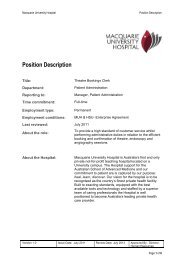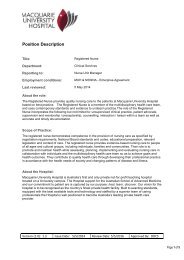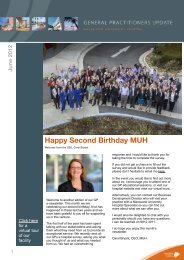Plenary Oral Presentations - Macquarie University Hospital
Plenary Oral Presentations - Macquarie University Hospital
Plenary Oral Presentations - Macquarie University Hospital
You also want an ePaper? Increase the reach of your titles
YUMPU automatically turns print PDFs into web optimized ePapers that Google loves.
16 th International Meeting of the Leksell Gamma Knife ® SocietyMarch 2012, Sydney, AustraliaMA-81Prognostic factors for Gamma Knife Radio-surgery in patientswith ≥5 brain metastasesLilyana Angelov, Alireza M. Mohammadi, Robert Weil, Samuel Chao, Nicholas Marko,Michael Vogelbaum, John Suh, Gennady Neyman, Gene BarnettRose Ella Burkhardt Brain Tumor and Neuro-Oncology Center Cleveland Clinic USAObjective: Gamma-Knife radio-surgery (GK) is one of the mainstays of treatment in patients withbrain metastases, especially for 4 or fewer lesions. Currently there is an increasing interest in offeringthis treatment modality to patients with a more extensive intracranial burden of disease (≥5 metastases)as an upfront treatment or in combination with whole brain radiation therapy (WBRT). However,data is lacking specifically related to the outcomes and prognostic factors in this subgroup of patients.In this study, prognostic factors contributing to overall survival (OS) of patients with ≥5 brain metastaseswere evaluated.Methods: An IRB approved retrospective review of 170 patients with ≥5 brain metastases treated atthe Cleveland Clinic GK Center (1997-2010) was performed. Patient demographics, tumor characteristics,treatment related factors as well as outcome of treatment were evaluated. Statistical analysiswas performed using Kaplan-Meier survival summaries and Cox proportional hazards regression.Results: Patient median age was 58 and female/male ratio was 94/76. The most common primary siteswere lung 84(49%) and breast 34(20%). At the time of GK, 70(41%) of the patients had multipleextracranial metastases, and KPS was ≥90 in 66(39%) of patients. Most of the patients 135(79%)were recursive partitioning analysis (RPA) class II and median graded prognostic index (GPA) was1.5. Median total intracranial disease volume was 3.25cc(range 0.19-37.19cc) with a tumor volumeof ≥10cc in 32(19%) of patients. Median number of lesions was 6(range 5-20). Median OS after GKwas 6.8 months. At the time of GK, older age, lower KPS, extensive extracranial disease burden,higher RPA class, lower GPA, non-lung primary pathology, and higher total intracranial tumor volumewere statistically significant poor prognostic factors using univariate analysis. Multivariate analysisdemonstrated lower KPS, multiple extracranial metastases and higher intracranial tumor volume weresignificant negative prognostic factors.Conclusions: In this large series of GK treated patients with ≥5 brain metastases, OS was significantlyimproved in patients with higher KPS and without extensive systemic involvement. Further, the totalintracranial disease burden was more relevant than the actual number of lesions. This data suggeststhat GK should be considered an appropriate treatment modality in the management of multiple brainmetastases.36
















